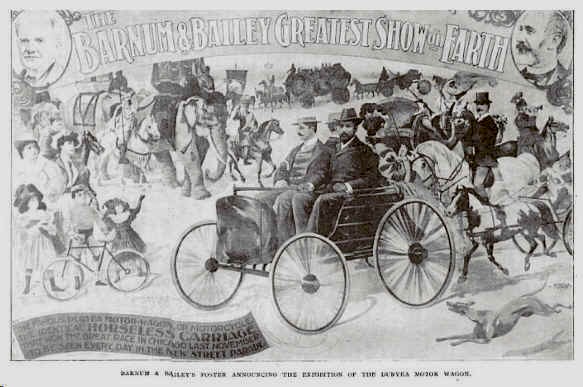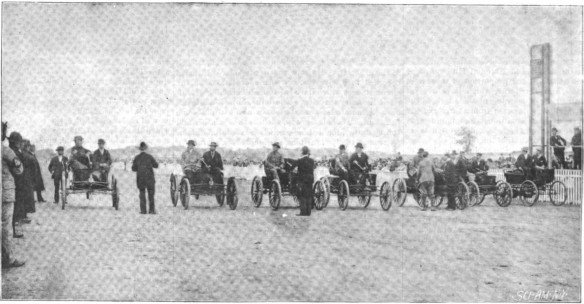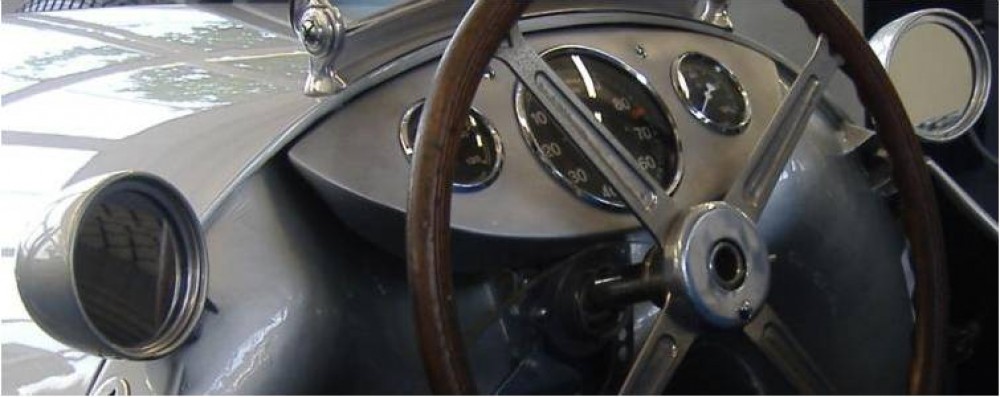What if, I thought, one were to compose a listing of all the national champions of the American Automobile Association, real or imagined, along with those also named as champion drivers during those years? As it turned out, this is how the listing looked:
1902 Harry Harkness 1903 Barney Oldfield
1904 George Heath 1905 Barney Oldfield, Victor Hemery
1906 Joe Tracy 1907 Eddie Bald
1908 Louis Strang 1909 Bert Dingley, George Robertson
1910 Ray Harroun, Ralph Mulford, Ralph De Palma
1911 Ralph De Palma, Harvey Herrick, Ralph Mulford
1912 Ralph DePalma, Teddy Tetzlaff, Bob Burman, Louis Disbrow, Joe Dawson
1913 Earl Cooper 1914 Ralph DePalma
1915 Earl Cooper, Eddie Rickenbacher, Gil Anderson, Dario Resta
1916 Dario Resta 1917 Earl Cooper
1918 Ralph Mulford 1919 Eddie Hearne, Howard Wilcox
1920 Gaston Chevrolet, Tommy Milton
1921 Tommy Milton 1922 Jimmy Murphy
1923 Eddie Hearne 1924 Jimmy Murphy
1925 Peter DePaolo 1926 Harry Hartz
1927 Peter DePaolo 1928 Louis Meyer
1929 Louis Meyer 1930 Billy Arnold
1931 Louis Schneider 1932 Bob Carey
1933 Louis Meyer 1934 Bill Cummings
1935 Kelly Petillo 1936 Mauri Rose
1937 Wilbur Shaw 1938 Floyd Roberts
1939 Wilbur Shaw 1940 Rex Mays
1941 Rex Mays 1942-45 No Racing: World War II
1946 Ted Horn 1947 Ted Horn
1948 Ted Horn 1949 Johnnie Parsons
1950 Henry Banks 1951 Tony Bettenhausen
1952 Chuck Stevenson 1953 Sam Hanks
1954 Jimmy Bryan 1955 Bob Sweikert
For the period from 1902 to 1920, I then decided to assign the origin or source of each season’s champion driver. In those cases when there were several sources, I then selected the earliest publication date for a source naming that champion. That led to some interesting sources being listed, along with some instances where another source might have been more familiar to some. Here is that listing:
1902 Harry Harkness (Russ Catlin)
1903 Barney Oldfield (Russ Catlin)
1904 George Heath (Russ Catlin)
1905 Barney Oldfield (AAA)
1905 Victor Hemery (Russ Catlin)
1906 Joe Tracy (Russ Catlin)
1907 Eddie Bald (Russ Catlin)
1908 Louis Strang (Russ Catlin)
1909 Bert Dingley (Motor Age)
1909 George Robertson (Russ Catlin)
1910 Ray Harroun (Motor Age)
1910 Ralph Mulford (Motor Age)
1910 Ralph De Palma (The Horseless Age)
1911 Ralph De Palma (The Automobile)
1911 Harvey Herrick (Motor Age)
1911 Ralph Mulford (Arthur Means)
1912 Ralph DePalma (Motor Age)
1912 Teddy Tetzlaff (Los Angeles Times)
1912 Bob Burman (New York Times)
1912 Louis Disbrow (The Horseless Age)
1912 Joe Dawson (The Horseless Age)
1913 Earl Cooper (Motor Age)
1914 Ralph DePalma (The Horseless Age)
1915 Earl Cooper (The Horseless Age)
1915 Eddie Rickenbacher (The Horseless Age)
1915 Gil Anderson (Motor Age)
1915 Dario Resta (MoToR)
1916 Dario Resta (AAA)
1917 Earl Cooper (Arthur Means)
1918 Ralph Mulford (Arthur Means)
1919 Eddie Hearne (Motor Age)
1919 Howard Wilcox (Arthur Means)
1920 Gaston Chevrolet (AAA)
1920 Tommy Milton (Arthur Means)
I then added the other possible contemporary sources, whether a publication, an individual or an organization, that was in agreement with the cited source regarding that season’s champion driver. I also allowed for the naming of multiple champion drivers during a season by a source. In addition, I then added whether the American Automobile Association (AAA), the United States Auto Club (USAC), Championship Auto Racing Teams (CART), or the INDYCAR organization recognized that champion driver. That resulted in this very interesting and even informative listing:
1902 Harry Harkness (Russ Catlin) (AAA, USAC)
1903 Barney Oldfield (Russ Catlin) (AAA, USAC)
1904 George Heath (Russ Catlin) (AAA, USAC)
1905 Barney Oldfield (AAA)
1905 Victor Hemery (Russ Catlin) (AAA, USAC)
1906 Joe Tracy (Russ Catlin) (AAA, USAC)
1907 Eddie Bald (Russ Catlin) (AAA, USAC)
1908 Louis Strang (Russ Catlin) (AAA, USAC)
1909 Bert Dingley (Motor Age) (Arthur Means, AAA)
1909 George Robertson (Russ Catlin) (AAA, USAC, CART, INDYCAR)
1910 Ray Harroun (Motor Age) (Arthur Means, AAA, Russ Catlin, USAC, CART, INDYCAR)
1910 Ralph Mulford (Motor Age) (New York Times)
1910 Ralph De Palma (The Horseless Age)
1911 Ralph De Palma (The Automobile)
1911 Harvey Herrick (Motor Age)
1911 Ralph Mulford (Arthur Means) (AAA, Russ Catlin)
1912 Ralph DePalma (Motor Age) (Chicago Tribune, The Horseless Age, Arthur Means, AAA, Russ Catlin, USAC, CART, INDYCAR)
1912 Teddy Tetzlaff (Los Angeles Times)
1912 Bob Burman (New York Times)
1912 Louis Disbrow (The Horseless Age)
1912 Joe Dawson (The Horseless Age)
1913 Earl Cooper (Motor Age) (The Horseless Age, Arthur Means, AAA, Russ Catlin, USAC, CART, INDYCAR)
1914 Ralph DePalma (The Horseless Age) Motor Age, MoToR, Arthur Means, AAA, Russ Catlin, USAC, CART, INDYCAR)
1915 Earl Cooper (The Horseless Age) (Motor Age, MoToR, Arthur Means, AAA, Russ Catlin, USAC, CART, INDYCAR)
1915 Eddie Rickenbacher (The Horseless Age) (Motor Age)
1915 Gil Anderson (Motor Age)
1915 Dario Resta (MoToR)
1916 Dario Resta (AAA)
1917 Earl Cooper (Arthur Means) (AAA, Russ Catlin, USAC, CART, INDYCAR)
1918 Ralph Mulford (Arthur Means) (AAA, Russ Catlin, USAC, CART, INDYCAR)
1919 Eddie Hearne (Motor Age)
1919 Howard Wilcox (Arthur Means) (AAA, Russ Catlin, USAC, CART, INDYCAR)
1920 Gaston Chevrolet (AAA)
1920 Tommy Milton (Arthur Means) (AAA, Russ Catlin, USAC, CART, INDYCAR)
I then eliminated, except for those years that the origin for a champion driver was the AAA, the original source for a champion driver. Where there was not a supporting person or organization for that champion, I eliminated that driver. That led to this listing:
1902 Harry Harkness (AAA, USAC)
1903 Barney Oldfield (AAA, USAC)
1904 George Heath (AAA, USAC)
1905 Barney Oldfield (AAA)
1905 Victor Hemery (AAA, USAC)
1906 Joe Tracy (AAA, USAC)
1907 Eddie Bald (AAA, USAC)
1908 Louis Strang (AAA, USAC)
1909 Bert Dingley (Arthur Means, AAA)
1909 George Robertson (AAA, USAC, CART, INDYCAR)
1910 Ray Harroun (Arthur Means, AAA, Russ Catlin, USAC, CART, INDYCAR)
1911 Ralph Mulford (AAA, Russ Catlin)
1912 Ralph DePalma (Chicago Tribune, The Horseless Age, Arthur Means, AAA, Russ Catlin, USAC, CART, INDYCAR)
1913 Earl Cooper (The Horseless Age, Arthur Means, AAA, Russ Catlin, USAC, CART, INDYCAR)
1914 Ralph DePalma (Motor Age, MoToR, Arthur Means, AAA, Russ Catlin, USAC, CART, INDYCAR)
1915 Earl Cooper (Motor Age, MoToR, Arthur Means, AAA, Russ Catlin, USAC, CART, INDYCAR)
1915 Eddie Rickenbacher (Motor Age)
1916 Dario Resta (AAA)
1917 Earl Cooper (AAA, Russ Catlin, USAC, CART, INDYCAR)
1918 Ralph Mulford (AAA, Russ Catlin, USAC, CART, INDYCAR)
1919 Howard Wilcox (AAA, Russ Catlin, USAC, CART, INDYCAR)
1920 Gaston Chevrolet (AAA)
1920 Tommy Milton (AAA, Russ Catlin, USAC, CART, INDYCAR)
I then compiled a listing of those champion drivers recognized in some form or fashion by the AAA, USAC, CART or INDYCAR. That resulted in this not entirely unfamiliar listing:
1902 Harry Harkness (AAA, USAC)
1903 Barney Oldfield (AAA, USAC)
1904 George Heath (AAA, USAC)
1905 Barney Oldfield (AAA)
1905 Victor Hemery (AAA, USAC)
1906 Joe Tracy (AAA, USAC)
1907 Eddie Bald (AAA, USAC)
1908 Louis Strang (AAA, USAC)
1909 Bert Dingley (AAA)
1909 George Robertson (AAA, USAC, CART, INDYCAR)
1910 Ray Harroun (AAA, USAC, CART, INDYCAR)
1911 Ralph Mulford (AAA)
1912 Ralph DePalma ( AAA, USAC, CART, INDYCAR)
1913 Earl Cooper (AAA, USAC, CART, INDYCAR)
1914 Ralph DePalma (AAA, USAC, CART, INDYCAR)
1915 Earl Cooper (AAA, USAC, CART, INDYCAR)
1916 Dario Resta (AAA)
1917 Earl Cooper (AAA, USAC, CART, INDYCAR)
1918 Ralph Mulford (AAA, USAC, CART, INDYCAR)
1919 Howard Wilcox (AAA, USAC, CART, INDYCAR)
1920 Gaston Chevrolet (AAA)
1920 Tommy Milton (AAA, USAC, CART, INDYCAR)






